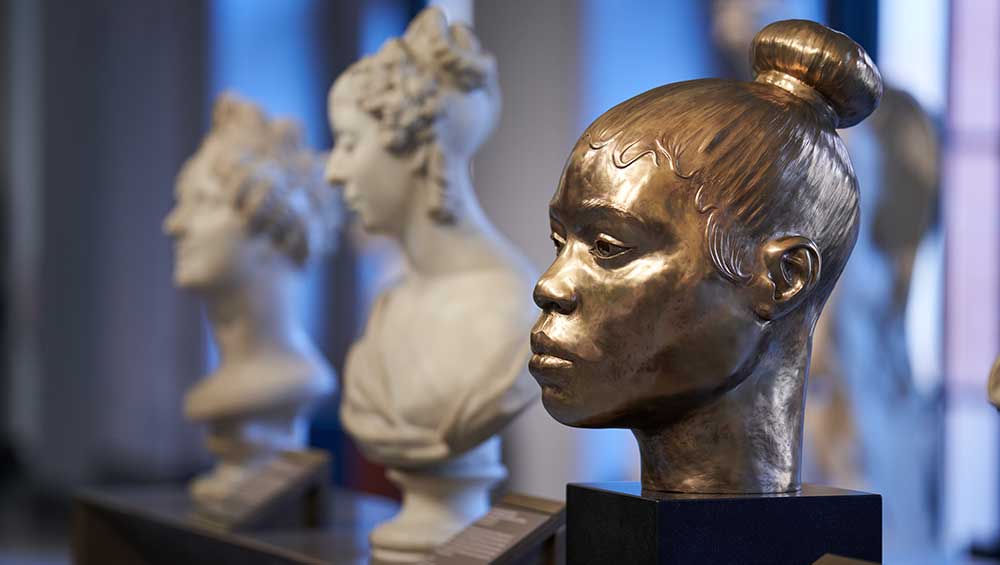
Thomas J Price at the V&A. © Thomas J Price. Courtesy the artist and Hauser & Wirth.
Victoria and Albert Museum, London
22 July 2023 – 27 May 2024
by BETH WILLIAMSON
The Victoria and Albert Museum (V&A) is well known for its sculpture galleries and, in particular, the long narrow gallery that stretches like a supporting spine through the centre of its ground floor spaces. With tiled floors and arched windows and niches running the length of each side, it is a memorable sight for anyone who has ever visited. There are notable works by Michelangelo, Bernini and Rodin in a collection that includes sculpture from the fourth century to the present day in a range of materials. The rooms within this gallery hold different categories of sculpture. There are “ideal” sculptures that represent mythological or allegorical subjects. There are 18th-century garden sculptures, monuments and follies used to populate landscaped gardens at that time. There are portrait busts and funerary monuments, too. Now it also contains a sculptural intervention by the artist Thomas J Price.
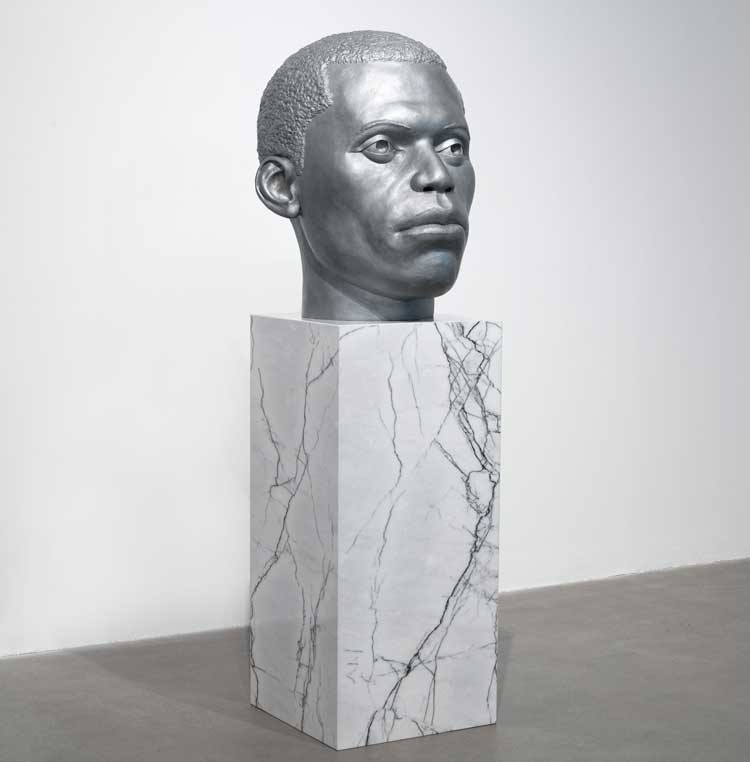
Thomas J Price. Numen (Shifting Votive One), 2016. Aluminium, marble , 187 x 57 x 63 cm (73 5/8 x 22 1/2 x 24 3/4 in). Photo: Ken Adlard.
Price is recognised as one of the leading sculptors of his generation and, if we are to understand his work in terms of what artists have made previously, his figurative sculptures sit somewhere between the ideal and the portrait. Depicting everyday individuals, these sculptures are striking and meditative. Price’s work interrogates ideas of monument, representation and value, prompting viewers to reflect on prejudices about status and appearance. Eight works by Price, installed throughout the sculpture gallery and nearby, convey a shared humanity that engenders radical empathy in the viewer, a genuine shift in our efforts to understand, suspend judgment and connect to others. The dialogue between Price’s contemporary sculpture and objects from the V&A’s historic collection serves to add an important further layer of meaning.
You could be forgiven for thinking that Price’s sculptures are straightforward portraits – they are not. He describes them as psychological portraits, although even that could be misconstrued. Rather than depicting a single subject, each sculpture is a fiction, a fusion of ordinary people encountered on London’s streets by the artist. He makes considered decisions about materials, scale and method of display. His purpose is to challenge sculptural traditions, to speak to issues of visibility, identity and objectification of Black people in visual culture and instead celebrate our human connections.
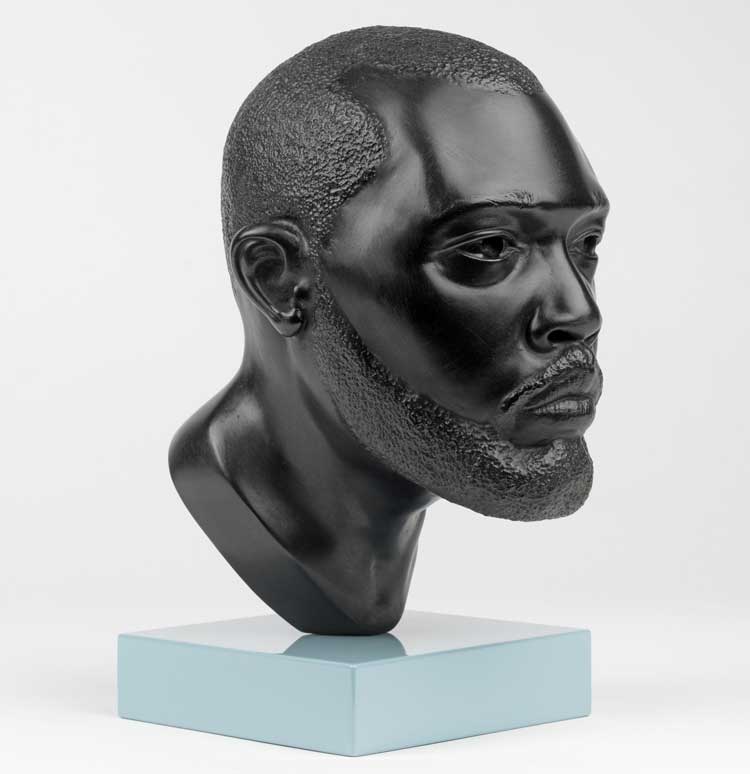
Thomas J Price. Untitled (Head 24), 2021. Bronze, perspex, automotive spray paint, 26 x 11 x 18 cm (10 1/4 x 4 3/8 x 7 1/8 in). Photo: Ken Adlard.
Price grew up visiting the museum and was intensely aware of the absence of figures he could relate to. Now, he says: “The intervention of my work endeavours to shift preconceived notions around status and identity, igniting new and expansive connections between the objects on view and visitors within the space.” So, how does this play out?
Before you even enter the building, Price’s monumental bronze work Moments Contained (2022), located in the Exhibition Road courtyard, is, according to the artist, a sculpture about sculpture, about who gets to be represented in public spaces. A fictional woman in casual sportswear towers above us, challenging the marginalisation of those people not traditionally celebrated in public sculpture. The woman’s dignity and composure focus attention on shared experiences and connections. At the opposite end of the scale, the tiny bronze Signals (2021) is finished in shining gold patina. It shows a young man in sports clothing holding his mobile phone in the air, searching for a signal or connection.
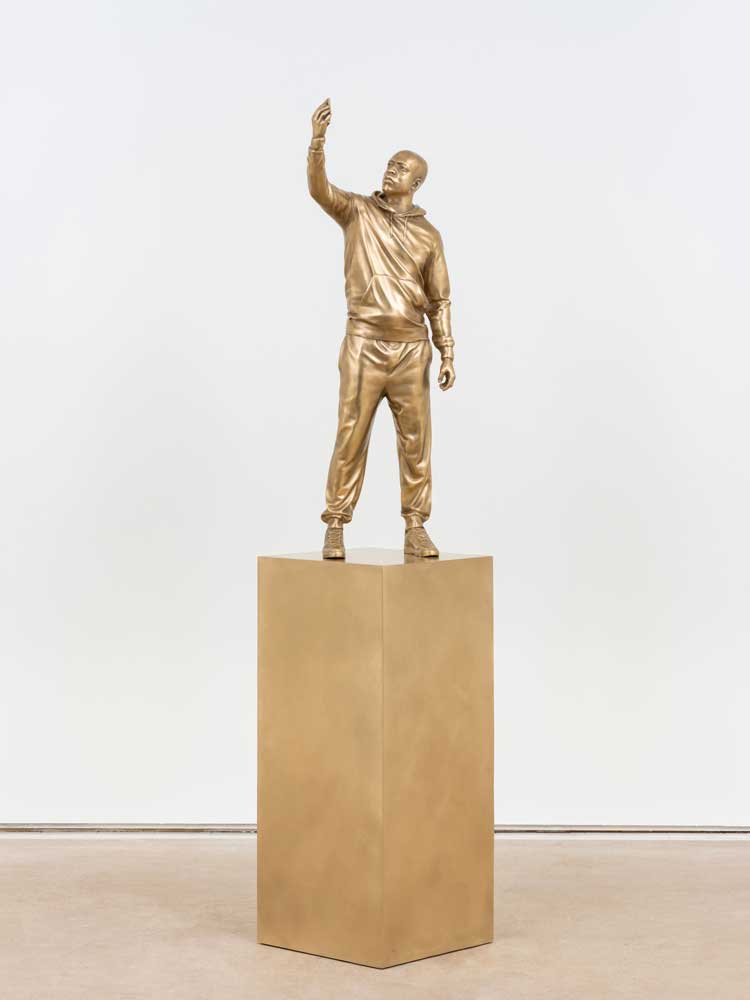
Thomas J Price. Signals, 2021. Bronze (Golden patina), 185 x 38 x 37 cm (72 7/8 x 15 x 14 5/8 in). Photo: Damian Griffiths.
Technology in the contemporary world becomes a tool for connectedness and understanding. What signals do we send out in public and what signals do we receive from others? What is most remarkable about this sculpture is the man’s heroic pose. It is displayed alongside Vincenzo Foggini’s Samson and the Philistines (1749) and the similarities in the pose are striking. However, Foggini’s Samson is using the jawbone of an ass to kill two Philistines in a violent act. In contrast, Price’s young man is using a mobile phone too seek communication with others in an action that connects people to one another. On a similarly small scale is Price’s Tasman Road, Figure 2 (2008), a diminutive nude male figure, one of a series named after streets in London (Abel Tasman was a Dutch explorer). The meaning here is complex and profound. Streets are often named after powerful white men, so Price reclaims that by using it as a title for his sculpture of a Black man. The figure is nude, small in scale and with an open stance. All these factors contribute to the figure’s vulnerability but, despite that, he is simply an ordinary man asserting his presence in the gallery with quiet dignity. He is surrounded by works by Rodin, giving a stoic strength to Tasman’s demeanour in this place.
.jpg)
Thomas J Price. Lay It Down (On The Edge Of Beauty), 2018. Bronze, automotive spray paint, 61 x 35 x 40 cm (24 x 13 3/4 x 15 3/4 in). Photo: Ken Adlard. © Thomas J Price. Courtesy the artist and Hauser & Wirth.
Four larger than life-size busts by Price occupy various positions in the sculpture gallery. Lay It Down (On the Edge of Beauty) (2018) is truly embedded within the collection as it sits in line with historic busts. Made of bronze and granite, it is polished to shine like gold, resembling a deity while remaining recognisably contemporary. Price has given the woman a specific hairstyle to emphasise the appropriation of Black hairstyles by white models and the associated erasure of a Black female presence left languishing “on the edge of beauty”. The remaining three busts by Price, all inspired by ancient sculpture, are from his Numen (Shifting Votive) series – numen means divinity or divine presence in Latin and votive relates to worship. These marble and aluminium heads prompt us to reflect on who we admire and respect, and who has become the object of the public’s worship today. These busts are portraits of everyone and no one. Even their mode of making is subversive as Price uses the traditional process of lost-wax casting not with bronze but with aluminium, a material more usually associated with engineering than sculpture.
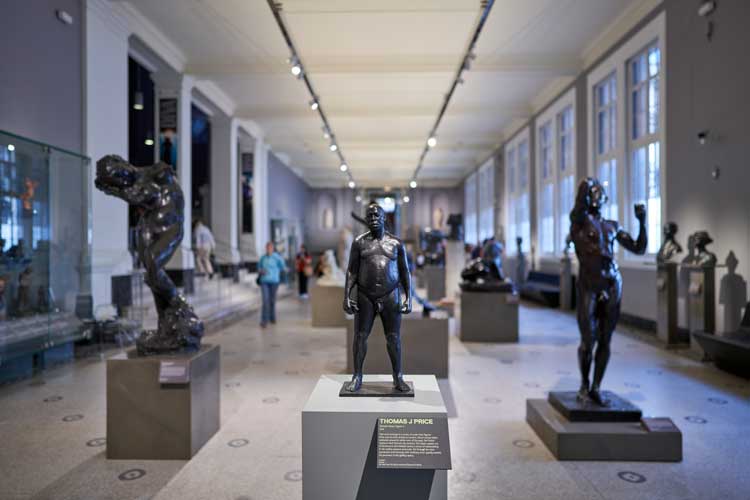
Thomas J Price at the V&A. © Thomas J Price. Courtesy the artist and Hauser & Wirth.
Displayed among the V&A’s collection, Price’s sculptures speak to us on different levels – individual and collective, contemporary and historic. Ultimately, Price’s intervention uses figurative sculpture of differing scale, material and demeanour to call out individual prejudices in attitude and understanding, underline exclusionary cultural values and commonalities, and encourage connection and communication.